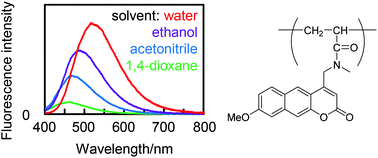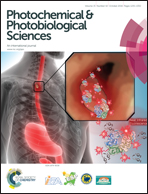A fluorescent acrylamide-type monomer bearing an environment-sensitive methoxybenzocoumarin structure for the development of functional polymeric sensors†
Abstract
A new fluorescent acrylamide-type monomer bearing a hydrogen bonding- and polarity-sensitive benzocoumarin fluorophore was synthesized. The absorption spectra, fluorescence spectra, and fluorescence lifetime of a model compound were measured in ten solvents with different hydrogen-bonding abilities and polarities to investigate the sensitivity of the fluorophore to the surrounding environment. These spectroscopic studies demonstrated that the fluorophore emits stronger fluorescence in more protic, polar environments. A fluorescent polymeric thermometer was prepared from N-isopropylacrylamide and the new fluorescent monomer, and it showed good functionality in aqueous solution (e.g., high sensitivity to temperature changes and high chemical stability), indicating the applicability of the herein developed fluorescent monomer for use in functional sensors.


 Please wait while we load your content...
Please wait while we load your content...